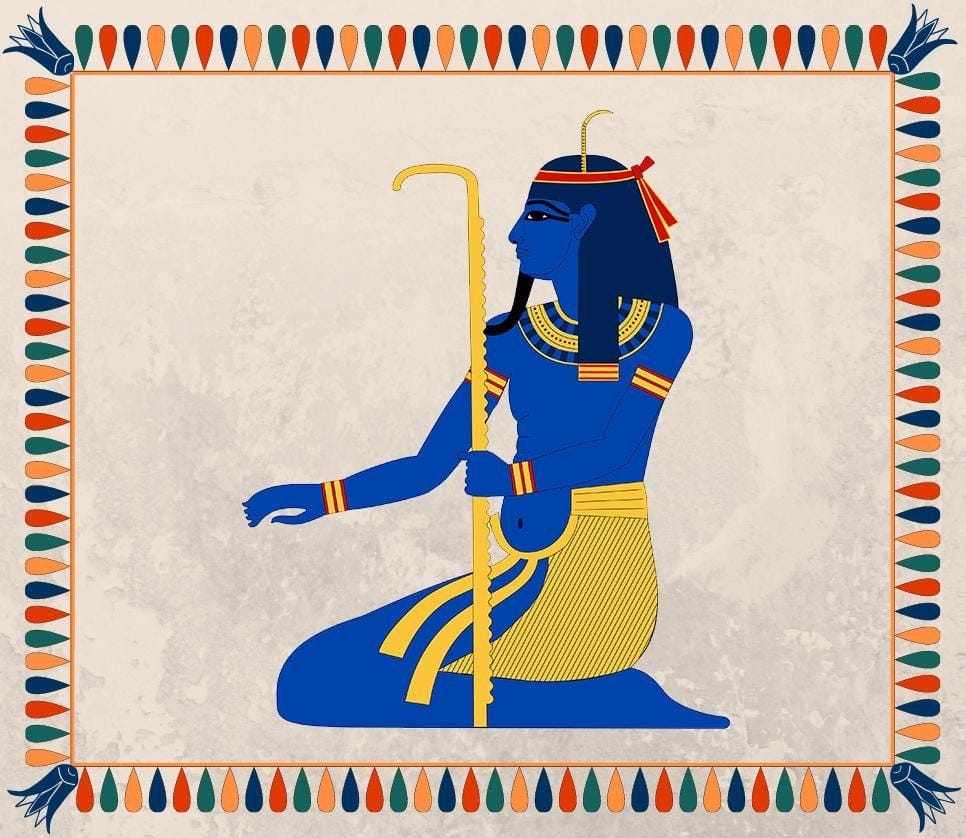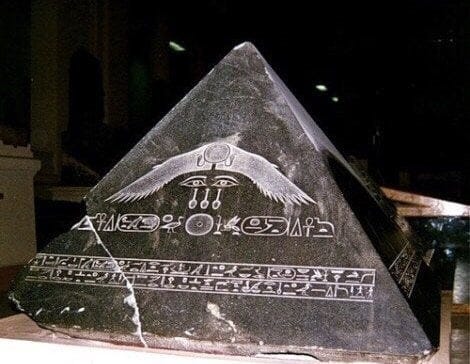Across time and culture, one mystery has united humanity: Where did it all begin?
From the swirling chaos of ancient myths to the blazing birth of stars, every civilization has wrestled with the same awe-inspiring questions - Who shaped the world? What forces breathe life into the void? And how will it all end?
So for the next few weeks, we’re diving into the greatest story ever told: the origin of everything. We’ll explore the first sparks of life, from the primal waters of Ancient Egypt to the first breath of the Greek gods, and beyond.
But this is only the beginning. Once the world is born, what happens when it unravels? Stay, for after creation comes destruction. The end of all things is just as fascinating.
Ancient Egyptian Cosmogony𓂀𓋹𓆣𓆃
The ancient Egyptians envisioned a universe born from chaos (Isfet), where creation itself was an act of divine order…
Primordial Waters and the Beginning of Creation
In the ancient Egyptian worldview, creation began from a vast, chaotic ocean - Nun (or Nu). This primordial sea, formless and boundless, existed before anything could take shape, representing the infinite potential for what was to come. Egyptian cosmogony does not start with a divine being or a defined plan, but with an undefined ocean of nothingness, where the seeds of creation awaited awakening. Nun, both a literal and symbolic entity, signifies the ultimate state of pre-creation where order had not yet emerged from disorder.
The first spark of creation is often tied to the first light, the first breath, or the first act that shatters the primordial waters. This is marked by the concept of Zep Tepi, or "The First Occasion," a mythological time when the sun first rose over the dark waters.
The benben stone, a pyramid-shaped mound that rises from the waters, was a symbolic representation of this first solid ground, and it was often linked to the sun god Ra. The benben or primeval mound appears repeatedly in Egyptian mythology, providing a visual symbol of the world rising from chaos.
Creation as the Ordering of Chaos
Creation for the ancient Egyptians was not merely an act of bringing something new into existence, it was about bringing order (Ma'at) to chaos (Isfet). The Egyptian cosmos was one in which ma'at (cosmic order) was constantly maintained through the divine actions of the gods. Every act of creation, governance and ritual sought to uphold her principles.
Hail to thee, O Nile!
Who manifests thyself over this land, and comes to give life to Egypt! - Hymn to the Nile
The imagery of chaos and order is visible in the Egyptian portrayal of the Nile River: a river that, when flooding, both destroyed and renewed. This relationship between destruction and renewal was mirrored in the gods' actions, as they continually brought order to the chaotic waters. The flooding of the Nile was a yearly reminder of the fluid relationship between chaos and order, with the same waters that receded from the land ultimately bringing life back to Egypt.
In this way, creation myths were not simply about the origin of the world, but about the maintenance of harmony and balance, reflecting the Egyptians’ constant efforts to uphold ma'at in both the physical and spiritual realms.
Creator Deities and the Structure of the Cosmos
At the heart of Egyptian cosmogony lies the figure of Atum, the self-creating god who emerged from the chaos of Nun. Atum’s emergence signifies the beginning of everything, not as a singular act of creation but as the first step in the formation of the divine order. In some versions of the myth, Atum is said to have created himself by willing his own existence or through the act of masturbation — a unique and deeply symbolic act that underscores the primal power of the divine. The self-created god was not simply a figure of power but one of self-determination, embodying the ability to shape the world from nothing.
Ra, often considered the most important deity in Egypt, shares this origin story. In many myths, Ra is Atum’s later incarnation, emerging from the primeval waters as the sun god and bringing light to the world. The creation of the Ennead, the group of nine gods in the Heliopolitan creation myth is typically attributed to Atum and Ra, with each god representing an essential force in the cosmic order.
Atum’s descendants, such as Shu (air), Tefnut (moisture), Geb (earth), and Nut (sky), are the building blocks of the ordered world. Each god or goddess symbolizes a specific element of existence and their relationships to one another form the basic structure of the universe. This divine family structure is foundational in Egyptian thought, underscoring the Egyptians' understanding of balance…both among the gods and between the elements they represent.
Unconventional Acts of Creation
In Egyptian creation myths, divine acts of creation are often far from conventional. The gods do not create through thought alone or passive willpower. But through acts that seem spontaneous and unpredictable. Ra’s tears, for instance, were said to give birth to humanity, implying that the act of creation itself was both emotional and physical. The gods’ bodily fluids, whether sweat, saliva or tears were seen as potent sources of life. This concept speaks to the Egyptians' belief in the intimacy between the divine and the mundane: creation wasn’t just the work of distant, abstract gods; it was something deeply personal and tied to the very essence of being.
In other stories, people were created by Khepera (Khepri), the scarab-faced god of rebirth and transformation, who molded them from his own divine flesh, shaping each being with purpose and intention. Another tradition claims that humans were formed from the 𓂀 Eye of Ra (Wedjat) 𓂀, a powerful and multifaceted symbol representing divine vision, protection and creative and destructive forces associated with protection, wrath and creativity.
Regional Variations in Creation Myths
Ancient Egypt was not a singular, homogenous culture; its cities and regions developed distinct mythologies that highlighted their local gods. These variations enrich the Egyptian religious landscape and suggest that there were multiple, competing visions of creation throughout Egypt’s long history.
Heliopolis
The Heliopolitan creation myth, which centers on Atum, is perhaps the most well-known. It describes how Atum emerged from the primordial waters of Nun, created the first gods, and set in motion the rest of creation. The creation of the Ennead (a group of nine deities) was foundational to Egyptian religious practice.
Hermopolis
In contrast, the Hermopolitan myth centers on the Ogdoad, a group of eight primordial deities who personify the qualities of the waters before creation: darkness, chaos, infinity, and the like. The deities of the Ogdoad are as follows:
Nun and Naunet: Representing the primordial waters, Nun embodies the chaotic, formless abyss, while Naunet complements this by symbolizing the depth of the watery void.
Heh and Hauhet: Symbolizing infinity and the boundlessness of time, Heh represents the concept of endlessness, while Hauhet embodies the endless space that fills the universe before the structured cosmos.
Kek and Kauket: These deities personify darkness and obscurity. Kek represents the primordial darkness, the absence of light, while Kauket complements him by symbolizing the gloom or shadowed state of the early universe.
Amun and Amaunet: Representing hiddenness and air, Amun symbolizes the concealed, invisible force of creation, and Amaunet represents the mysterious, veiled aspect of the world that surrounds it.
Together, the Ogdoad encapsulates the state of the universe before the world came into being: an endless, dark, watery and boundless chaos. Their roles are not just mythological but also philosophical, as they embody abstract forces that explain the origin of time, space and existence itself.
Memphis
The Memphite creation myth is unique. It centers on Ptah, the god of craftsmanship. Rather than creating through physical acts like the other gods, Ptah is said to have created the world through thought and speech, using his heart and tongue to bring forth the cosmos.
Highlights the importance of divine intelligence in shaping the world.
Thebes
Sometimes centered on Amun, a mysterious and hidden god whose presence was felt rather than seen. He eventually merged with Ra, the sun god, forming Amun-Ra, a powerful composite deity who combined invisibility with radiance. Amun represented a more abstract and transcendent force than many other gods — a divine mind or breath that pervaded the cosmos. While Atum and Ra were seen in the light of the sun or the physical act of creation, Amun remained cloaked in mystery, a deity of wind, air and the unseen.
The Divine Origins of Humanity
The idea of humans coming from a god’s tears or body fluids shows how the Egyptians saw a close, almost personal link between the gods and the beginning of human life.
And, to them, cosmos was ever-shifting, where creation and destruction were inseparable. In this view, the beginning and the end are always intertwined. The daily journey of the sun god Ra, who was said to die each night in the underworld and be reborn every morning, was a prime example of this view.
Until next time!❤️













